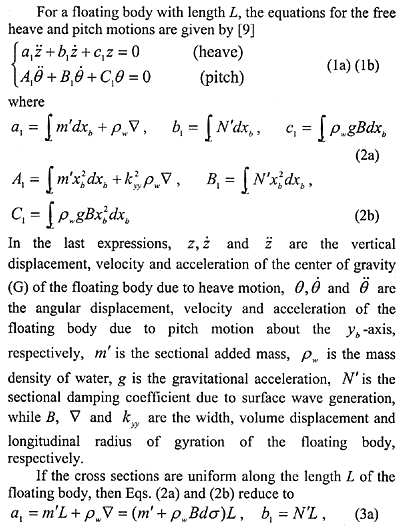TS-93
An Experimental Method for Determining the Frequency-Dependent Added Mass and Added Mass Moment of Inertia for A Finned Floating Body in Heave and Pitch Motions
Jong-Shyong Wu* and Mang Hsieh
ABSTRACT
The purpose of this study is to determine the added mass mah and the added mass moment of inertia Iap of the floating bodies with fins when they undergo heave and pitch motions in still water surface by using the authors' developed experimental method [8]. Instead of the existing method to obtain the added mass mh of a floating body from the "forced" vibration responses at resonance, a simple experimental method is presented, where the values of mh and Iap are obtained from the "free" vibration responses of a floating body (model) and a spring-shaft shaker.
KEY WORDS: Added mass, added mass moment of inertia, finned floating body (model), spring-shaft shaker.
1. INTRODUCTION
Since 1929 Lewis presented a paper to state the inertia of water surrounding a vibration ship [1], a lot of researchers devoted themselves to the studies of the relationships between the sectional added mass coefficients ( Cv, CH or Cr ) and area coefficient σ and beam/draft ratio β [2,3]. As to the effect of shallow water or narrow water way on the added mass, the materials concerned are much fewer [4]. In the above-mentioned literature, the values of the sectional added mass coefficients were obtained under the assumption that the length of the floating body is infinite (i.e., L→∞) so that the end effect may be neglected. But according to reference [5], the three-dimensional effect must be considered in general.
Although it is evident that the influence of the oscillating frequency on the added mass of a floating body should be significant, the information in this area is rare. In the existing literature, the added mass coefficients for the floating bodies performing heave motions, Cv, are obtained by using the "resonant" technique [6,7]. However, the resonant conditions are not easily obtained with good accuracy in experiments, hence the implementation of the resonant technique is usually very difficult. For this reason, the authors have presented a simple experimental method [8] to improve the drawback of the existing "resonant" technique. Where all the oscillating frequencies based on which the added mass of the floating body being evaluated are the natural frequencies of free vibrations rather than the exciting frequencies of forced vibrations for the oscillating system. In reference [8], only the added mass mah and the added mass moment of inertia Iap for the floating bodies "without" fins are studied, in this paper, those for the floating bodies "with" fins are studied and then the influence of some fin parameters, such as fin length lf and fin angle θf, on the values of mah and Iap are presented.
The experimental equipment consists of a water tank (5 m long × 2 m wide × 1.5 m deep), a spatial framework, a planar framework, a spring-shaft shaker, a floating body (or model) and some measuring instruments. Four models (floating bodies), each with length L = 0.6 m, were studied in this paper. The cross sections of two of them (Model 1(a) and 1(b)) are rectangular (with area coefficients σ = 1.0) and those of the other two are Lewis forms (with area coefficients σ = 0.785 at draft d = 0.08 m). Each model is equipped with two fins on its port and starboard. The cases studied are: fin lengths lf= 0.5L and L; fin angles θf =30°, 60° and 90°.
2. FORMULATION OF THE PROBLEM
2.1 Equations of Motions

*Corresponding author, professor
Institute of Naval Architecture and Marine Engineering
National Cheng-Kung University
Tainan, Taiwan 701, Republic of Chaina
Fax: +886-6-2747019
E-mail: jswu@mail.ncku.edu.tw